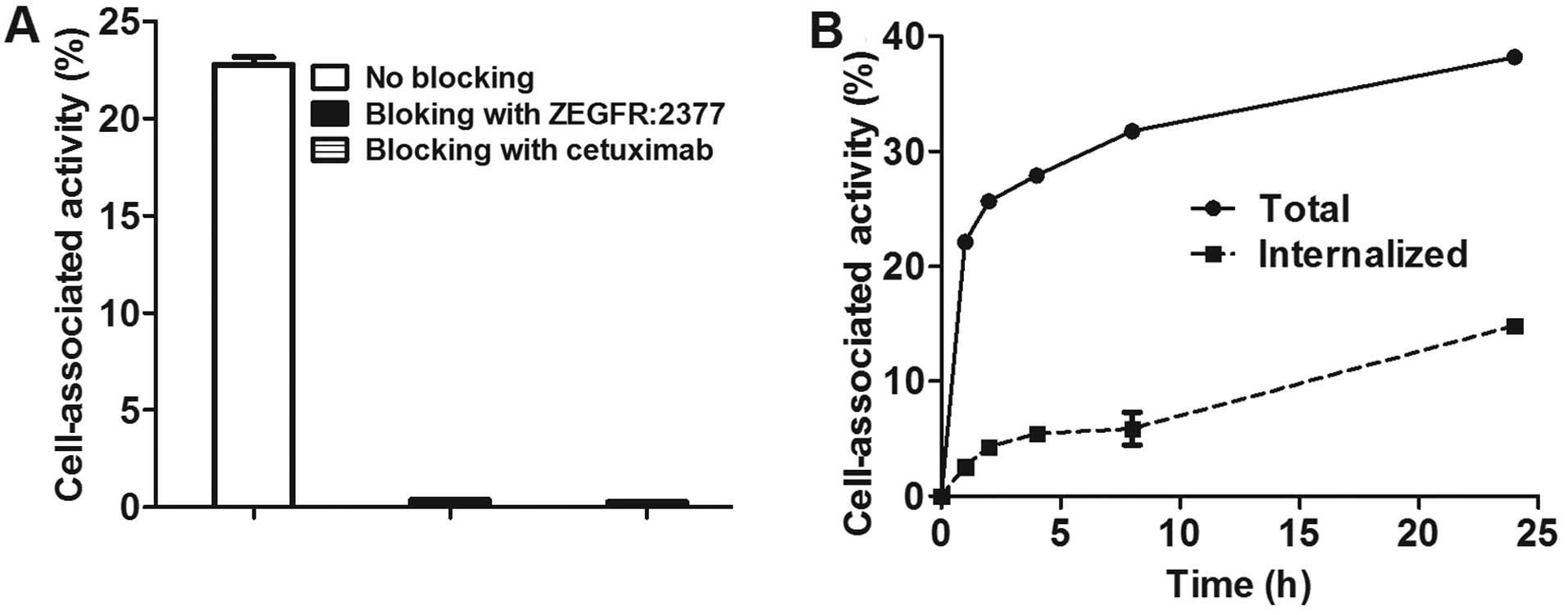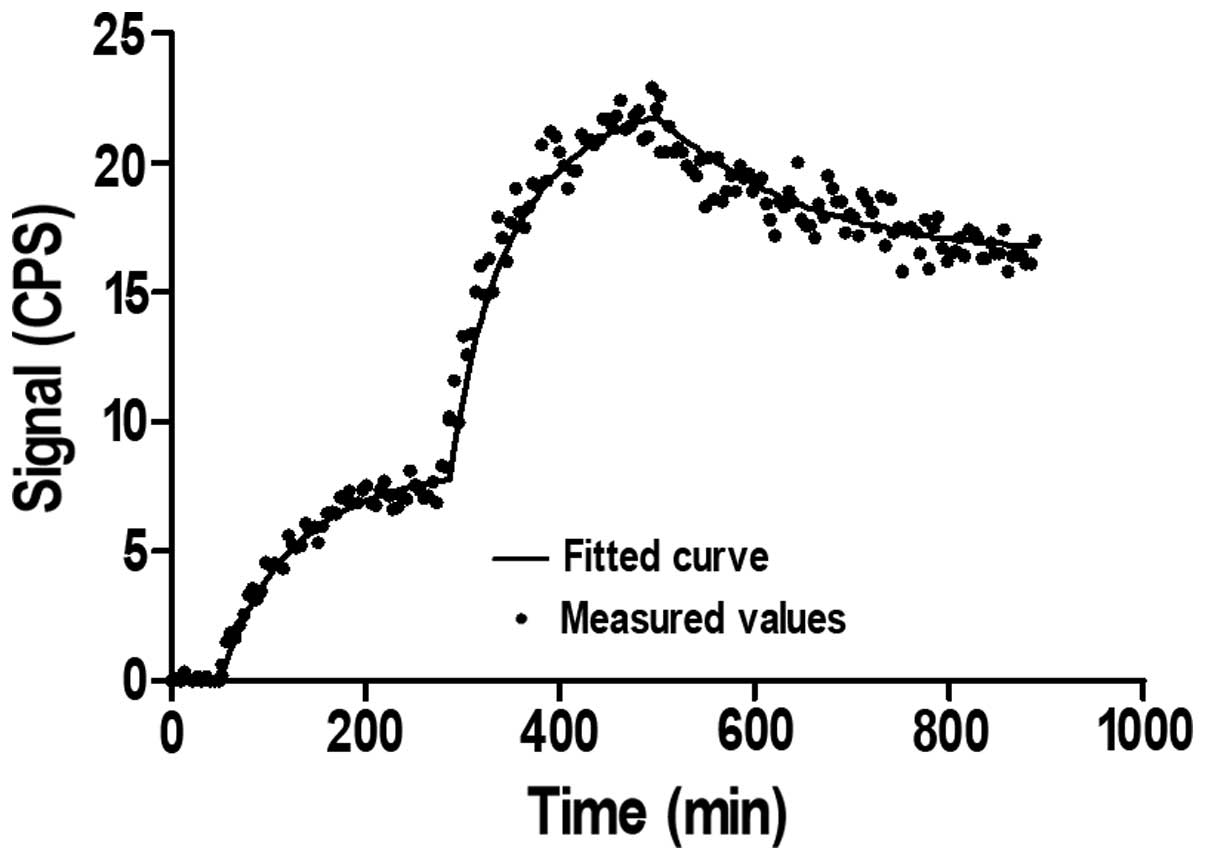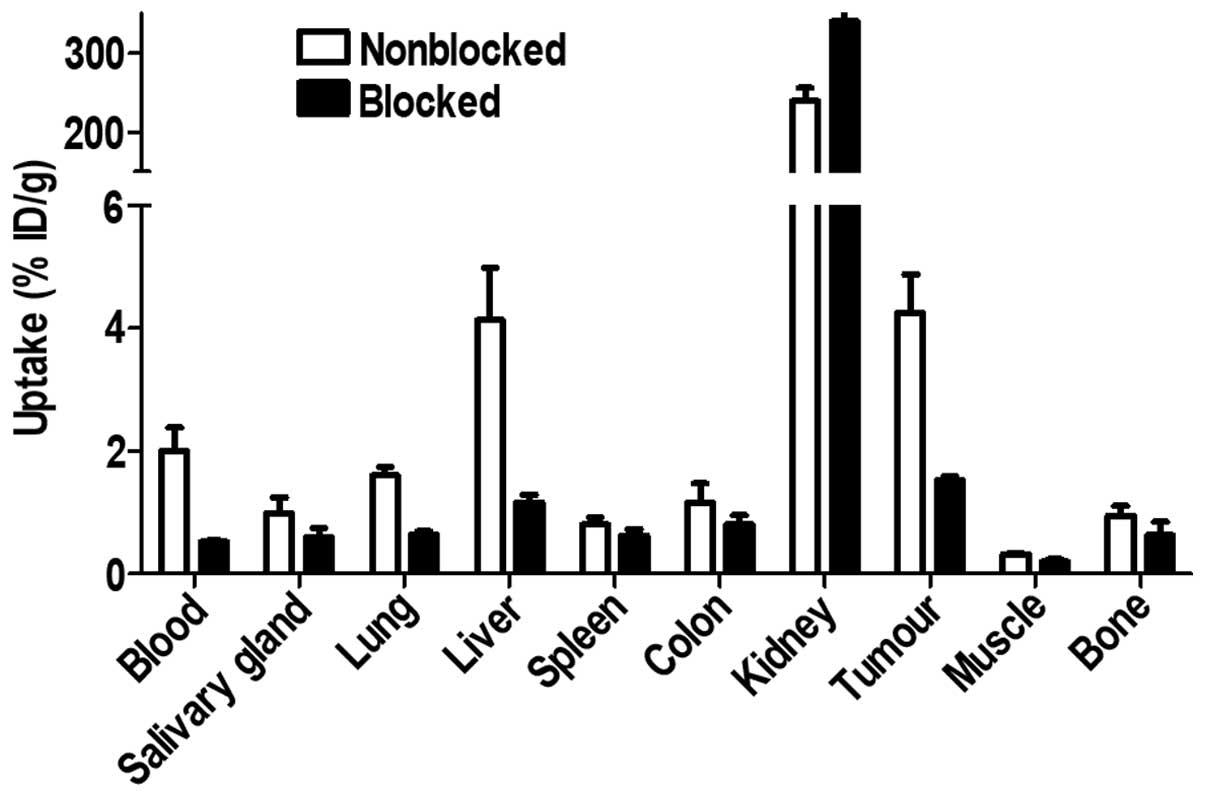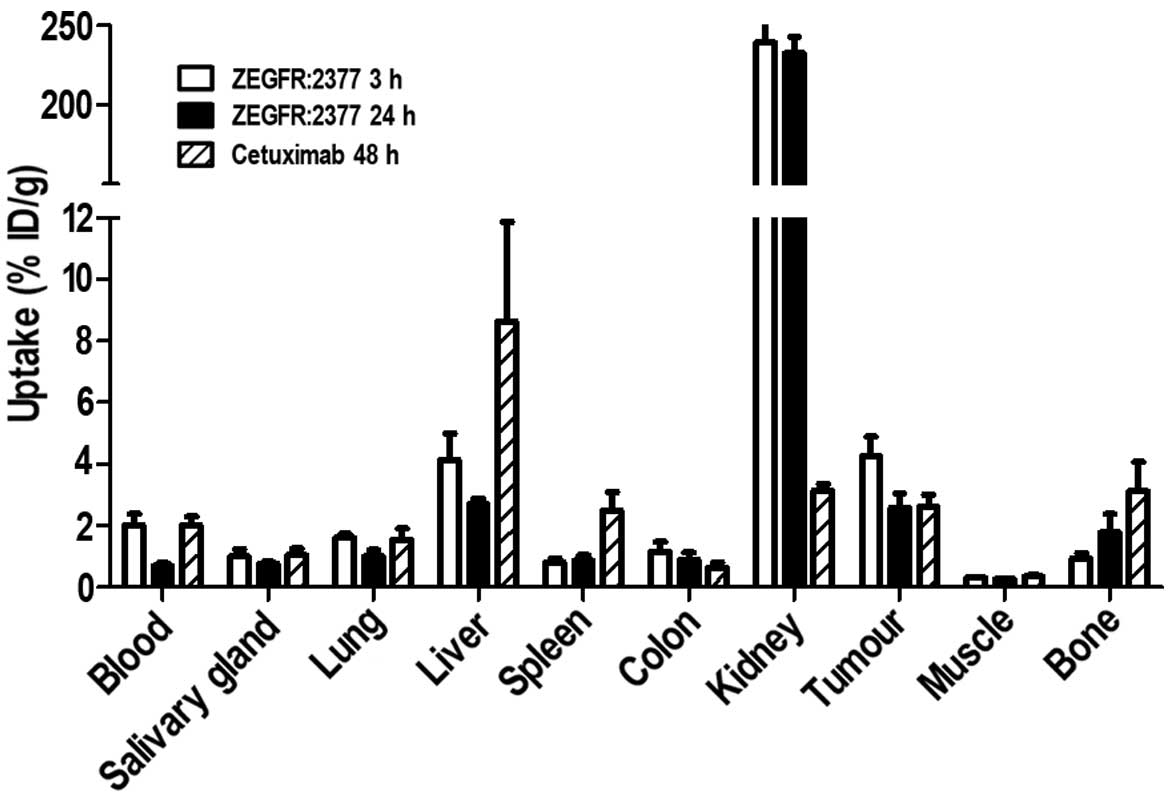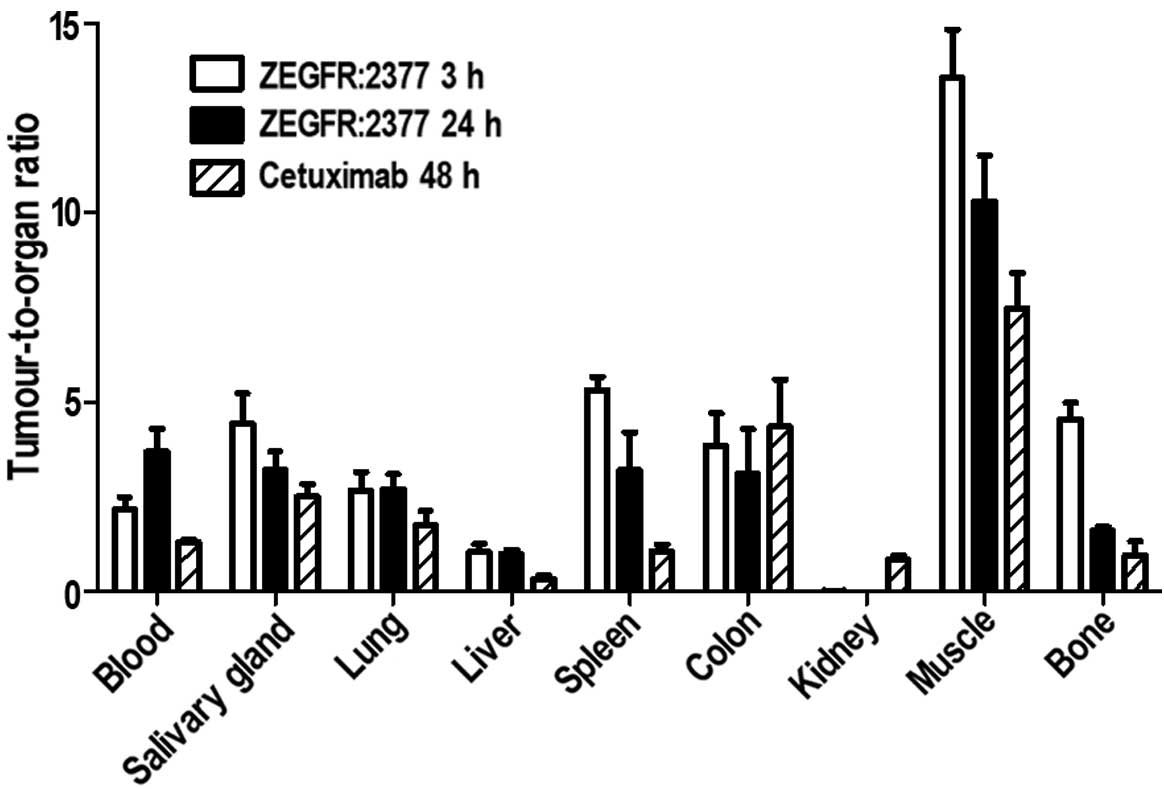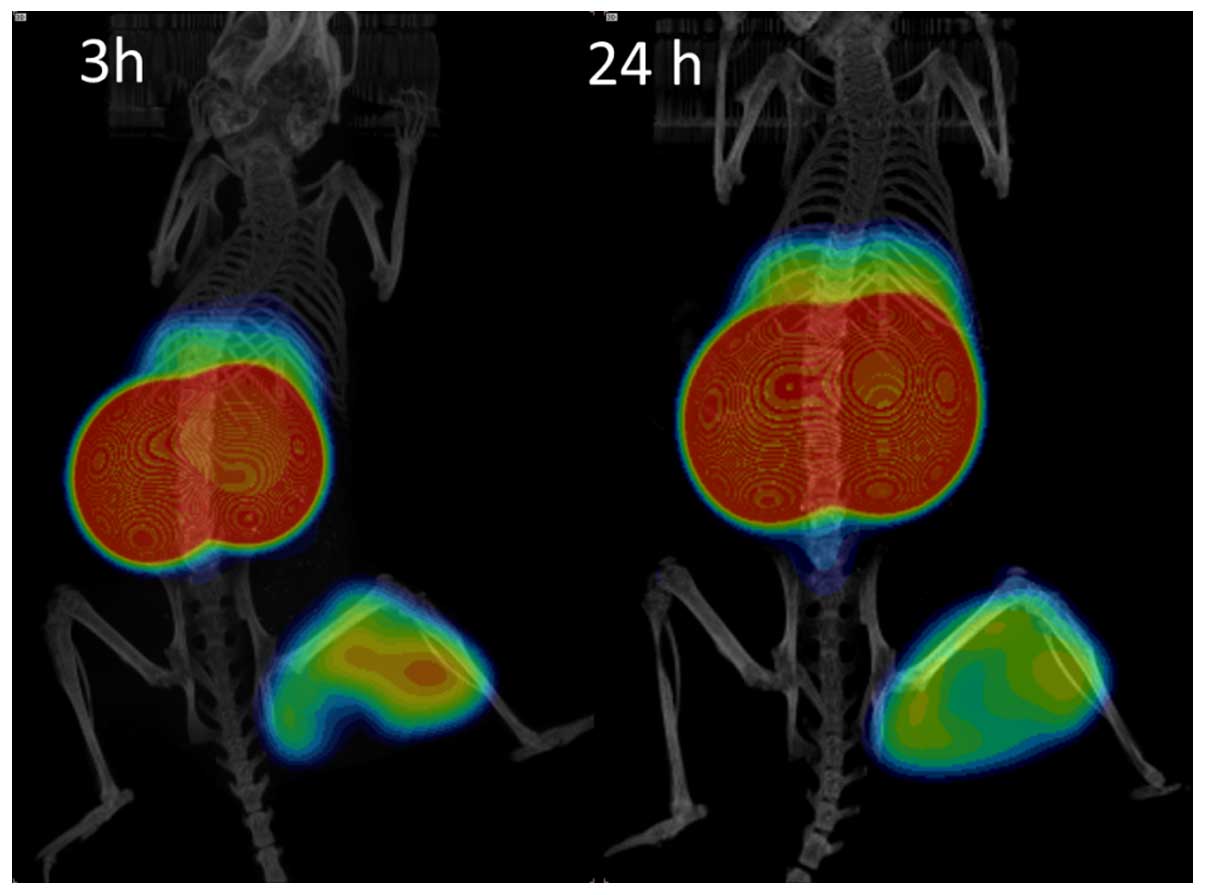|
1
|
Mendelsohn J and Baselga J: Epidermal
growth factor receptor targeting in cancer. Semin Oncol.
33:369–385. 2006. View Article : Google Scholar : PubMed/NCBI
|
|
2
|
Scaltriti M and Baselga J: The epidermal
growth factor receptor pathway: A model for targeted therapy. Clin
Cancer Res. 12:5268–5272. 2006. View Article : Google Scholar : PubMed/NCBI
|
|
3
|
Goffin JR and Zbuk K: Epidermal growth
factor receptor: Pathway, therapies, and pipeline. Clin Ther.
35:1282–1303. 2013. View Article : Google Scholar : PubMed/NCBI
|
|
4
|
Ang KK, Andratschke NH and Milas L:
Epidermal growth factor receptor and response of head-and-neck
carcinoma to therapy. Int J Radiat Oncol Biol Phys. 58:959–965.
2004. View Article : Google Scholar : PubMed/NCBI
|
|
5
|
Tsutsui S, Kataoka A, Ohno S, Murakami S,
Kinoshita J and Hachitanda Y: Prognostic and predictive value of
epidermal growth factor receptor in recurrent breast cancer. Clin
Cancer Res. 8:3454–3460. 2002.PubMed/NCBI
|
|
6
|
Selvaggi G, Novello S, Torri V, Leonardo
E, De Giuli P, Borasio P, Mossetti C, Ardissone F, Lausi P and
Scagliotti GV: Epidermal growth factor receptor overexpression
correlates with a poor prognosis in completely resected
non-small-cell lung cancer. Ann Oncol. 15:28–32. 2004. View Article : Google Scholar
|
|
7
|
Humbert O, Riedinger JM, Charon-Barra C,
Berriolo-Riedinger A, Desmoulins I, Lorgis V, Kanoun S, Coutant C,
Fumoleau P, Cochet A and Brunotte F: Identification of biomarkers
including 18FDG-PET/CT for early prediction of response
to neoadjuvant chemotherapy in triple negative breast cancer. Clin
Cancer Res. 21:5460–5468. 2015. View Article : Google Scholar : PubMed/NCBI
|
|
8
|
Ang KK, Berkey BA, Tu X, Zhang HZ, Katz R,
Hammond EH, Fu KK and Milas L: Impact of epidermal growth factor
receptor expression on survival and pattern of relapse in patients
with advanced head and neck carcinoma. Cancer Res. 62:7350–7356.
2002.PubMed/NCBI
|
|
9
|
Cappuzzo F, Hirsch FR, Rossi E, Bartolini
S, Ceresoli GL, Bemis L, Haney J, Witta S, Danenberg K, Domenichini
I, et al: Epidermal growth factor receptor gene and protein and
gefitinib sensitivity in non-small-cell lung cancer. J Natl Cancer
Inst. 97:643–655. 2005. View Article : Google Scholar : PubMed/NCBI
|
|
10
|
Hirsch FR, Varella-Garcia M, Bunn PA Jr,
Franklin WA, Dziadziuszko R, Thatcher N, Chang A, Parikh P, Pereira
JR, Ciuleanu T, et al: Molecular predictors of outcome with
gefitinib in a phase III placebo-controlled study in advanced
non-small-cell lung cancer. J Clin Oncol. 24:5034–5042. 2006.
View Article : Google Scholar : PubMed/NCBI
|
|
11
|
Pirker R, Pereira JR, von Pawel J,
Krzakowski M, Ramlau R, Park K, de Marinis F, Eberhardt WE,
Paz-Ares L, Störkel S, et al: EGFR expression as a predictor of
survival for first-line chemotherapy plus cetuximab in patients
with advanced non-small-cell lung cancer: Analysis of data from the
phase 3 FLEX study. Lancet Oncol. 13:33–42. 2012. View Article : Google Scholar
|
|
12
|
Bradley JD, Paulus R, Komaki R, Masters G,
Blumenschein G, Schild S, Bogart J, Hu C, Forster K, Magliocco A,
et al: Standard-dose versus high-dose conformal radiotherapy with
concurrent and consolidation carboplatin plus paclitaxel with or
without cetuximab for patients with stage IIIA or IIIB
non-small-cell lung cancer (RTOG 0617): A randomised, two-by-two
factorial phase 3 study. Lancet Oncol. 16:187–199. 2015. View Article : Google Scholar : PubMed/NCBI
|
|
13
|
Bentzen SM, Atasoy BM, Daley FM, Dische S,
Richman PI, Saunders MI, Trott KR and Wilson GD: Epidermal growth
factor receptor expression in pretreatment biopsies from head and
neck squamous cell carcinoma as a predictive factor for a benefit
from accelerated radiation therapy in a randomized controlled
trial. J Clin Oncol. 23:5560–5567. 2005. View Article : Google Scholar : PubMed/NCBI
|
|
14
|
Vignot S, Besse B, André F, Spano JP and
Soria JC: Discrepancies between primary tumor and metastasis: A
literature review on clinically established biomarkers. Crit Rev
Oncol Hematol. 84:301–313. 2012. View Article : Google Scholar : PubMed/NCBI
|
|
15
|
Yarom N, Marginean C, Moyana T,
Gorn-Hondermann I, Birnboim HC, Marginean H, Auer RC, Vickers M,
Asmis TR, Maroun J, et al: EGFR expression variance in paired
colorectal cancer primary and metastatic tumors. Cancer Biol Ther.
10:416–421. 2010. View Article : Google Scholar : PubMed/NCBI
|
|
16
|
Wei Q, Shui Y, Zheng S, Wester K, Nordgren
H, Nygren P, Glimelius B and Carlsson J: EGFR, HER2 and HER3
expression in primary colorectal carcinomas and corresponding
metastases: Implications for targeted radionuclide therapy. Oncol
Rep. 25:3–11. 2011.
|
|
17
|
Gomez-Roca C, Raynaud CM, Penault-Llorca
F, Mercier O, Commo F, Morat L, Sabatier L, Dartevelle P, Taranchon
E, Besse B, et al: Differential expression of biomarkers in primary
non-small cell lung cancer and metastatic sites. J Thorac Oncol.
4:1212–1220. 2009. View Article : Google Scholar : PubMed/NCBI
|
|
18
|
Italiano A, Vandenbos FB, Otto J, Mouroux
J, Fontaine D, Marcy PY, Cardot N, Thyss A and Pedeutour F:
Comparison of the epidermal growth factor receptor gene and protein
in primary non-small-cell-lung cancer and metastatic sites:
Implications for treatment with EGFR-inhibitors. Ann Oncol.
17:981–985. 2006. View Article : Google Scholar : PubMed/NCBI
|
|
19
|
Goldenberg A, Masui H, Divgi C, Kamrath H,
Pentlow K and Mendelsohn J: Imaging of human tumor xenografts with
an indium-111-labeled anti-epidermal growth factor receptor
monoclonal antibody. J Natl Cancer Inst. 81:1616–1625. 1989.
View Article : Google Scholar : PubMed/NCBI
|
|
20
|
Divgi CR, Welt S, Kris M, Real FX, Yeh SD,
Gralla R, Merchant B, Schweighart S, Unger M, Larson SM, et al:
Phase I and imaging trial of indium 111-labeled anti-epidermal
growth factor receptor monoclonal antibody 225 in patients with
squamous cell lung carcinoma. J Natl Cancer Inst. 83:97–104. 1991.
View Article : Google Scholar : PubMed/NCBI
|
|
21
|
Cai W, Chen K, He L, Cao Q, Koong A and
Chen X: Quantitative PET of EGFR expression in xenograft-bearing
mice using 64Cu-labeled cetuximab, a chimeric anti-EGFR
monoclonal antibody. Eur J Nucl Med Mol Imaging. 34:850–858. 2007.
View Article : Google Scholar : PubMed/NCBI
|
|
22
|
Ping Li W, Meyer LA, Capretto DA, Sherman
CD and Anderson CJ: Receptor-binding, biodistribution, and
metabolism studies of 64Cu-DOTA-cetuximab, a PET-imaging
agent for epidermal growth-factor receptor-positive tumors. Cancer
Biother Radiopharm. 23:158–171. 2008. View Article : Google Scholar : PubMed/NCBI
|
|
23
|
Nayak TK, Garmestani K, Baidoo KE, Milenic
DE and Brechbiel MW: Preparation, biological evaluation, and
pharmacokinetics of the human anti-HER1 monoclonal antibody
panitumumab labeled with 86Y for quantitative PET of
carcinoma. J Nucl Med. 51:942–950. 2010. View Article : Google Scholar : PubMed/NCBI
|
|
24
|
Nayak TK, Garmestani K, Milenic DE and
Brechbiel MW: PET and MRI of metastatic peritoneal and pulmonary
colorectal cancer in mice with human epidermal growth factor
receptor 1-targeted 89Zr-labeled panitumumab. J Nucl
Med. 53:113–120. 2012. View Article : Google Scholar : PubMed/NCBI
|
|
25
|
Aerts HJ, Dubois L, Perk L, Vermaelen P,
van Dongen GA, Wouters BG and Lambin P: Disparity between in vivo
EGFR expression and 89Zr-labeled cetuximab uptake
assessed with PET. J Nucl Med. 50:123–131. 2009. View Article : Google Scholar
|
|
26
|
Chang AJ, De Silva RA and Lapi SE:
Development and characterization of 89Zr-labeled
panitumumab for immuno-positron emission tomographic imaging of the
epidermal growth factor receptor. Mol Imaging. 12:17–27.
2013.PubMed/NCBI
|
|
27
|
Cuartero-Plaza A, Martínez-Miralles E,
Rosell R, Vadell-Nadal C, Farré M and Real FX: Radiolocalization of
squamous lung carcinoma with 131I-labeled epidermal
growth factor. Clin Cancer Res. 2:13–20. 1996.PubMed/NCBI
|
|
28
|
Reilly RM, Kiarash R, Sandhu J, Lee YW,
Cameron RG, Hendler A, Vallis K and Gariépy J: A comparison of EGF
and MAb 528 labeled with 111In for imaging human breast
cancer. J Nucl Med. 41:903–911. 2000.PubMed/NCBI
|
|
29
|
Velikyan I, Sundberg AL, Lindhe O, Höglund
AU, Eriksson O, Werner E, Carlsson J, Bergström M, Långström B and
Tolmachev V: Preparation and evaluation of
68Ga-DOTA-hEGF for visualization of EGFR expression in
malignant tumors. J Nucl Med. 46:1881–1888. 2005.PubMed/NCBI
|
|
30
|
Li W, Niu G, Lang L, Guo N, Ma Y,
Kiesewetter DO, Backer JM, Shen B and Chen X: PET imaging of EGF
receptors using [18F] FBEM-EGF in a head and neck
squamous cell carcinoma model. Eur J Nucl Med Mol Imaging.
39:300–308. 2012. View Article : Google Scholar :
|
|
31
|
Löfblom J, Feldwisch J, Tolmachev V,
Carlsson J, Ståhl S and Frejd FY: Affibody molecules: Engineered
proteins for therapeutic, diagnostic and biotechnological
applications. FEBS Lett. 584:2670–2680. 2010. View Article : Google Scholar : PubMed/NCBI
|
|
32
|
Nygren PA: Alternative binding proteins:
Affibody binding proteins developed from a small three-helix bundle
scaffold. FEBS J. 275:2668–2676. 2008. View Article : Google Scholar : PubMed/NCBI
|
|
33
|
Ahlgren S and Tolmachev V: Radionuclide
molecular imaging using Affibody molecules. Curr Pharm Biotechnol.
11:581–589. 2010. View Article : Google Scholar : PubMed/NCBI
|
|
34
|
Feldwisch J and Tolmachev V: Engineering
of affibody molecules for therapy and diagnostics. Methods Mol
Biol. 899:103–126. 2012. View Article : Google Scholar : PubMed/NCBI
|
|
35
|
Sörensen J, Sandberg D, Sandström M,
Wennborg A, Feldwisch J, Tolmachev V, Åström G, Lubberink M,
Garske-Román U, Carlsson J, et al: First-in-human molecular imaging
of HER2 expression in breast cancer metastases using the
111In-ABY-025 affibody molecule. J Nucl Med. 55:730–735.
2014. View Article : Google Scholar
|
|
36
|
Friedman M, Orlova A, Johansson E,
Eriksson TL, Höidén-Guthenberg I, Tolmachev V, Nilsson FY and Ståhl
S: Directed evolution to low nanomolar affinity of a
tumor-targeting epidermal growth factor receptor-binding affibody
molecule. J Mol Biol. 376:1388–1402. 2008. View Article : Google Scholar : PubMed/NCBI
|
|
37
|
Tolmachev V, Friedman M, Sandström M,
Eriksson TL, Rosik D, Hodik M, Ståhl S, Frejd FY and Orlova A:
Affibody molecules for epidermal growth factor receptor targeting
in vivo: Aspects of dimerization and labeling chemistry. J Nucl
Med. 50:274–283. 2009. View Article : Google Scholar : PubMed/NCBI
|
|
38
|
Tolmachev V, Rosik D, Wållberg H, Sjöberg
A, Sandström M, Hansson M, Wennborg A and Orlova A: Imaging of EGFR
expression in murine xenografts using site-specifically labelled
anti-EGFR 111In-DOTA-ZEGFR:2377 Affibody
molecule: aspect of the injected tracer amount. Eur J Nucl Med Mol
Imaging. 37:613–622. 2010. View Article : Google Scholar
|
|
39
|
Vosjan MJ, Perk LR, Visser GW, Budde M,
Jurek P, Kiefer GE and van Dongen GA: Conjugation and radiolabeling
of monoclonal antibodies with zirconium-89 for PET imaging using
the bifunctional chelate p-isothiocyanatobenzyl-desferrioxamine.
Nat Protoc. 5:739–743. 2010. View Article : Google Scholar : PubMed/NCBI
|
|
40
|
Malmberg J, Tolmachev V and Orlova A:
Imaging agents for in vivo molecular profiling of disseminated
prostate cancer--targeting EGFR receptors in prostate cancer:
comparison of cellular processing of [111In]-labeled
affibody molecule ZEGFR:2377 and cetuximab. Int J Oncol.
38:1137–1143. 2011.PubMed/NCBI
|
|
41
|
Barta P, Malmberg J, Melicharova L,
Strandgård J, Orlova A, Tolmachev V, Laznicek M and Andersson K:
Protein interactions with HER-family receptors can have different
characteristics depending on the hosting cell line. Int J Oncol.
40:1677–1682. 2012.
|
|
42
|
Tolmachev V and Stone-Elander S:
Radiolabelled proteins for positron emission tomography: Pros and
cons of labelling methods. Biochim Biophys Acta. 1800.487–510.
2010.
|
|
43
|
Altai M, Strand J, Rosik D, Selvaraju RK,
Eriksson Karlström A, Orlova A and Tolmachev V: Influence of
nuclides and chelators on imaging using affibody molecules:
Comparative evaluation of recombinant affibody molecules
site-specifically labeled with 68Ga and 111In
via maleimido derivatives of DOTA and NODAGA. Bioconjug Chem.
24:1102–1109. 2013. View Article : Google Scholar : PubMed/NCBI
|
|
44
|
Heskamp S, Laverman P, Rosik D, Boschetti
F, van der Graaf WT, Oyen WJ, van Laarhoven HW, Tolmachev V and
Boerman OC: Imaging of human epidermal growth factor receptor type
2 expression with 18F-labeled affibody molecule
ZHER2:2395 in a mouse model for ovarian cancer. J Nucl
Med. 53:146–153. 2012. View Article : Google Scholar
|
|
45
|
Strand J, Varasteh Z, Eriksson O,
Abrahmsen L, Orlova A and Tolmachev V: Gallium-68-labeled affibody
molecule for PET imaging of PDGFRβ expression in vivo. Mol Pharm.
11(3): 957–3964. 2014. View Article : Google Scholar
|
|
46
|
Miao Z, Ren G, Liu H, Qi S, Wu S and Cheng
Z: PET of EGFR expression with an 18F-labeled affibody
molecule. J Nucl Med. 53:1110–1118. 2012. View Article : Google Scholar : PubMed/NCBI
|
|
47
|
Su X, Cheng K, Jeon J, Shen B, Venturin
GT, Hu X, Rao J, Chin FT, Wu H and Cheng Z: Comparison of two
site-specifically 18F-labeled affibodies for PET imaging
of EGFR positive tumors. Mol Pharm. 11:3947–3956. 2014. View Article : Google Scholar : PubMed/NCBI
|
|
48
|
Dijkers EC, Kosterink JG, Rademaker AP,
Perk LR, van Dongen GA, Bart J, de Jong JR, de Vries EG and Lub-de
Hooge MN: Development and characterization of clinical-grade
89Zr-trastuzumab for HER2/neu immunoPET imaging. J Nucl
Med. 50:974–981. 2009. View Article : Google Scholar : PubMed/NCBI
|
|
49
|
Terwisscha van Scheltinga AG, Lub-de Hooge
MN, Abiraj K, Schröder CP, Pot L, Bossenmaier B, Thomas M,
Hölzlwimmer G, Friess T, Kosterink JG, et al: ImmunoPET and
biodistribution with human epidermal growth factor receptor 3
targeting antibody 89Zr-RG7116. MAbs. 6:1051–1058. 2014.
View Article : Google Scholar : PubMed/NCBI
|
|
50
|
Dijkers EC, Oude Munnink TH, Kosterink JG,
Brouwers AH, Jager PL, de Jong JR, van Dongen GA, Schröder CP,
Lub-de Hooge MN and de Vries EG: Biodistribution of
89Zr-trastuzumab and PET imaging of HER2-positive
lesions in patients with metastatic breast cancer. Clin Pharmacol
Ther. 87:586–592. 2010. View Article : Google Scholar : PubMed/NCBI
|
|
51
|
Oosting SF, Brouwers AH, van Es SC,
Nagengast WB, Oude Munnink TH, Lub-de Hooge MN, Hollema H, de Jong
JR, de Jong IJ, de Haas S, et al: 89Zr-bevacizumab PET
visualizes heterogeneous tracer accumulation in tumor lesions of
renal cell carcinoma patients and differential effects of
antiangiogenic treatment. J Nucl Med. 56:63–69. 2015. View Article : Google Scholar
|
|
52
|
Fischer G, Seibold U, Schirrmacher R,
Wängler B and Wängler C: 89Zr, a radiometal nuclide with
high potential for molecular imaging with PET: Chemistry,
applications and remaining challenges. Molecules. 18:6469–6490.
2013. View Article : Google Scholar : PubMed/NCBI
|
|
53
|
Vegt E, de Jong M, Wetzels JF, Masereeuw
R, Melis M, Oyen WJ, Gotthardt M and Boerman OC: Renal toxicity of
radiolabeled peptides and antibody fragments: Mechanisms, impact on
radionuclide therapy, and strategies for prevention. J Nucl Med.
51:1049–1058. 2010. View Article : Google Scholar : PubMed/NCBI
|
|
54
|
Ahlgren S, Orlova A, Wållberg H, Hansson
M, Sandström M, Lewsley R, Wennborg A, Abrahmsén L, Tolmachev V and
Feldwisch J: Targeting of HER2-expressing tumors using
111In-ABY-025, a second-generation affibody molecule
with a fundamentally reengineered scaffold. J Nucl Med.
51:1131–1138. 2010. View Article : Google Scholar : PubMed/NCBI
|















